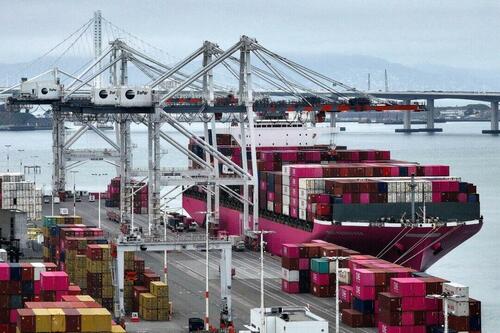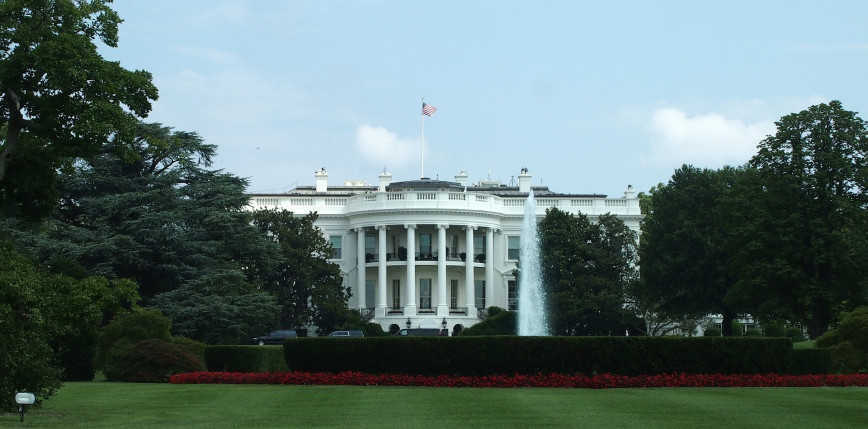
Trump’s Tariffs Deliver Record $23 Billion Revenue In May
U.S. tariff revenues reached an all-time high in May as President Donald Trump’s trade policies started to fill government coffers.
According to the May 28 Daily Treasury Statement, revenues from “customs and certain excise taxes” climbed to a record high of $23.28 billion this month, up from $17.431 billion in April.
May was the first full month that Trump’s levies took effect. Most of the tax collections occurred on May 22, exceeding $16 billion.
Shortly after his April 2 “Liberation Day” announcement, the administration imposed 10 percent tariffs on nearly every country in the world.
Fiscal year-to-date—the federal government’s fiscal year runs from October 1 to September 30—tariff revenues total $93.85 billion.

As Andrew Moran reports for The Epoch Times, Customs and Border Protection (CBP) says that it has been implementing and enforcing the president’s tariffs “using all our enforcement and revenue collection authorities.”
“CBP enforces tariffs through a combination of legal authority, advanced systems, and operational procedures designed to ensure that duties owed are paid,” the CBP said in a report earlier this month.
“We have fulfilled the demand and remain committed to facilitating legitimate trade while upholding a robust enforcement posture.”
Last month, the CBP conducted 33 audits, leading to the collection of $117 million in duties and fees owed to the U.S. government. Officials found that imported goods had been “improperly declared.”
Despite the sizable increase in tariff revenues, it still accounts for a relatively small portion of overall government receipts.
In April, Washington generated $850 billion in revenues, meaning levies represented approximately 2 percent of the total amount.
Despite the president’s estimates, tariffs are only producing less than $1 billion per day for the U.S. government.
President Donald Trump meets with Salvadoran President Nayib Bukele in the Oval Office of the White House on April 14, 2025. Brendan Smialowski/AFP via Getty Images
During a meeting with Salvadoran President Nayib Bukele last month, Trump stated that the United States was “taking in billions and billions of dollars” from his trade agenda.
“We were losing 2 billion a day. … Now we’re making $3 billion a day,” he said.
The president has repeatedly threatened new or higher tariffs since the “Make America Wealthy Again” event on April 2.
“Remember, I am empowered to ‘SET A DEAL’ for Trade into the United States if we are unable to make a deal, or are treated unfairly,” Trump said in a May 27 post on social media platform Truth Social.
Looking at Revenue Projections
Senior administration officials have presented substantial revenue projections based on the president’s tariff plans.
In a March 31 interview with “Fox News Sunday,” the president’s senior trade adviser, Peter Navarro, forecast that tariffs could raise approximately $600 billion a year, or about $6 trillion over a decade.
“The message is that tariffs are tax cuts, tariffs are jobs, tariffs are national security. Tariffs are great for America. They will make America great again,” Navarro said.
Treasury Secretary Scott Bessent speaks to reporters during a briefing at the White House on April 29, 2025. Travis Gillmore/The Epoch Times
Economists have presented more conservative estimates.
The Tax Foundation, for example, anticipates Trump’s higher import duties will lead to more than $2.1 trillion in revenue over 10 years.
Officials, including Treasury Secretary Scott Bessent, have suggested that tariffs could be a major source of income for the federal government. Speaking to reporters at a White House press briefing, Bessent stated that tariff revenue could “give income tax relief.”
This would, however, be only temporary.
According to the senior Cabinet secretary, reliance on tariff revenue would diminish as more companies onshore and reshore manufacturing, bolstering domestic income.
“If we’re successful, tariffs would be a melting ice cube, in a way, because you’re taking in the revenues as the manufacturing facilities are built in the U.S., and there should be some level of symmetry between the taxes we begin taking in with the new industry from the payroll taxes as the tariffs decline,” Bessent told CNBC’s “Squawk Box” on April 8.
The administration’s tariffs have now faced legal hurdles, which might throw a wrench in fiscal projections.
A three-judge panel at the New York-based U.S. Court of International Trade blocked the president’s global tariffs. A second court also handed down an order blocking Trump’s use of emergency powers to implement tariffs.
An appeals court ruled that the president’s tariffs could stay in place.
Scores of White House officials have shrugged off the legal roadblocks.
In a May 30 interview with CNBC’s “Squawk Box,” U.S. Trade Representative Jamieson Greer stated that the president has “other tools” to implement his trade agenda.
U.S. Trade Representative Jamieson Greer testifies before the Senate Finance Committee in the Dirksen Senate Office Building in Washington on April 8, 2025. Kayla Bartkowski/Getty Images
“All these things are on the table,” Greer said. “The reality is, we have this enormous trade deficit. It got worse over the Biden years, and if we don’t fix the global trading system, it’s just going to get even worse going forward. We have to fix it.”
According to the Census Bureau, the U.S. goods trade deficit narrowed sharply in April, declining to $87.6 billion. This is down 46 percent from the record high of $162.3 billion registered in March.
Tyler Durden
Fri, 05/30/2025 – 18:00








![Nowa ustawa o opiece ma mylący tytuł. Nie przewiduje żadnych nowych świadczeń dla opiekunów albo osób niepełnosprawnych, seniorów, osób samotnych [projekt]](https://g.infor.pl/p/_files/38661000/paragraf-38661468.jpg)

![[OGŁOSZENIE] Poszukiwani świadkowie uszkodzenia samochodu marki BYD na os. Złote Łany](https://img.bielskiedrogi.pl/2025/12/d3785ec7f437649ce7080b3e2456ded5_b4e7.jpeg)



